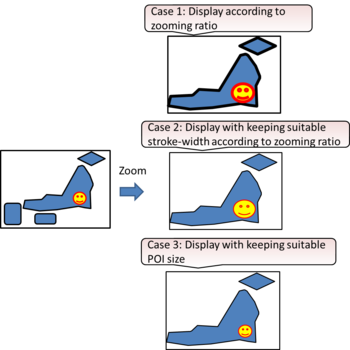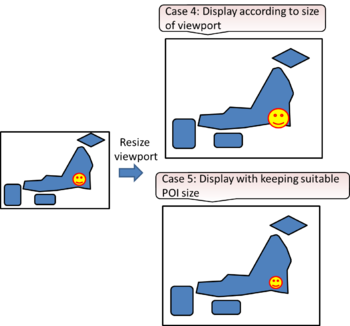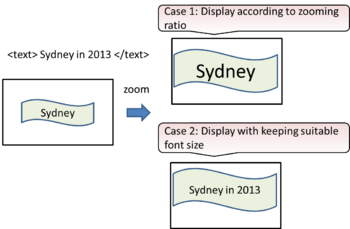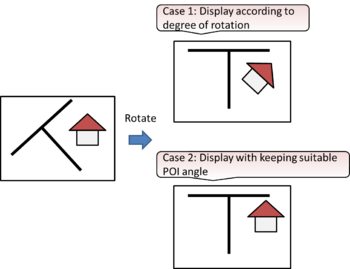F2F/Sydney 2013/NonScalingObject
Introduction
In this topic, requirements for "non-scaling objects" are clarified in order to promote a development of its specification based on the following resolution.
Note: Since KDDI mainly examined this document from the application side of mapping, these may be only a part of requirements for general-purpose non-scaling objects. KDDI desires the spec. as which these requirements were considered for application for Mapping to be edited.
The detailed requirements are described in section 1, and requirements for functionality derived from notion of "non-scaling object" are also shown in section 2. In addition, use cases for "non-scaling object" have already been introduced in SVG Open F2F 2012.
resolution: svg2 should include non-scaling features, aside from non-scaling stroke. (2 separate components: non-scaling part of the object, and non-scaling entire object)
1. Non-scaling object
A functionality of non-scaling object is essential in presenting POIs to a screen. The typical POIs are landmarks on a map (icons of station etc.) and icons for showing lesion areas in a X-ray photograph.
Display size of POI has several variations as depicted in the following.
1.1 Display of objects independent of zooming
When scaling parameters in a CTM (Current Transform Matrix) are changed (e.g. increase/decrease the width and height for viewbox attribute), it is required that specified objects can be displayed in a fixed size.
In case 1 of the following figure, all objects are resized according to zooming.
In case 2, all objects are resized with keeping suitable stroke width according to zooming. This is realized by setting "vector-effect" property to "non-scaling stroke" for SVG Tiny 1.2.
Also, in case 3, the specified objects are displayed in a fixed size independently of zooming. This is realized by setting "transform" attribute to "ref(svg,x,y)" for SVG Tiny 1.2.
Item to be standardized : Specification including a feature to enable a depiction of a fixed-size object independently of zooming as shown in the case 3
1.2 Display of objects independent of viewport resizing
When viewport size are changed by resizing window of UA, it is required that specified objects can be displayed in a fixed size.
In case 4 of the following figure, all objects are resized according to viewport resizing.
Meanwhile, in case 5 of the following figure, the specified objects are displayed in a fixed size independently of resizing. Probably this behavior can not be accomplished by ref(svg,x,y) of SVG Tiny 1.2.
Item to be standardized : Specification including a feature to enable a depiction of a fixed-size object independently of resizing viewport as shown in the case 5
2. Other possible effects for objects
If the concept of non-scaling object is interpreted, there are similar requirements for not only pure graphic element (circle, rect, and etc.) but also text element. In addition, it is required that objects fixed with respect to not only scaling but also rotating are displayed (e.g. in case of a car navigation system).
2.1 Non-scaling textfont
The following figure is an example in which a text element contains "Sydney in 2013" as a string content.
In case 1, a text object is displayed according to a zooming. Entire string content are not viewed in the screen due to shortage of a region for rendering.
Meanwhile, in case 2, a text object is displayed in a fixed font size independently of the zooming. Since zoom operation enlarges rendering area, the text object including hidden strings are displayed.
Item to be standardized : Specification including a feature to enable a depiction of the text object with a fixed-size font independently of the zooming as shown in the case 2
2.2 Non-rotating object
In case 1 of the following figure, uniformly-rotated objects are displayed according to a rotation operation.
Meanwhile, in case 2, specified objects are displayed with keeping a fixed angle independently of the rotation operation.
Item to be standardized : Specification including a feature to enable a depiction of an object with a fixed angle independently of the rotation as shown in the case 2



